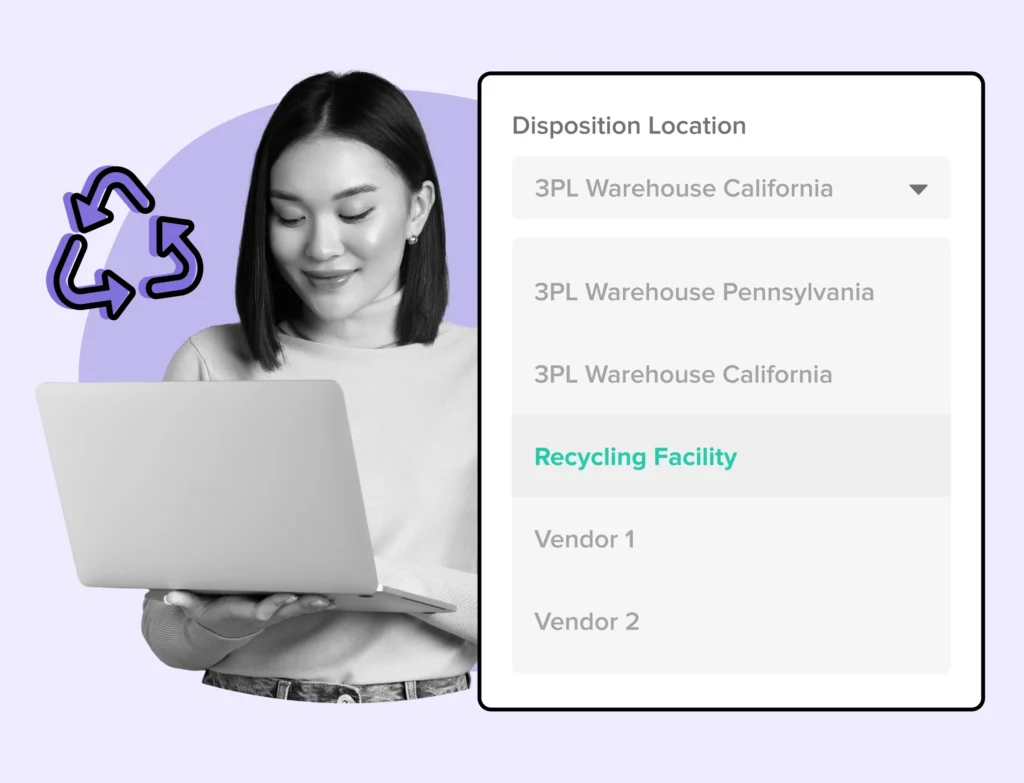
Boost eCommerce Profitability: 12 Simple Ways
Let’s dive deep into essential topics like managing profit margins, pricing tactics, improving customer experience, and leveraging data!
Shipping, Tracking & Notifications
Boost customer experience and reduce support tickets
Realtime order and shipment tracking
Proactive order and shipping notifications
AI-Enhanced Discounted Labels
Predictive pre-purchase estimated delivery dates
Self-Serivce branded order tracking
Effortless experience delivered
Identify and Resolve Order Issues
Realtime order and shipment tracking
Make returns profitable and delight customers
Flexibility to define any return destinations & conditions
Simplify returns for your customers and team
Incentivize exchanges over returns
Returns management made easy for your team
Returns management made easy for your team
Easy claims and smart upsells
Understand why your customers are returning
In-Store & Curbside Pickup
Unify the online and the in-store experience
Hassle-free pickup experience for customers
In-Store dashboard to keep operations streamlined
In-Store and Online orders unified
Drive foot-traffic to your stores
Shipping, Tracking & Notifications
Boost customer experience and reduce support tickets
Realtime order and shipment tracking
Proactive order and shipping notifications
AI-Enhanced Discounted Labels
Predictive pre-purchase estimated delivery dates
Self-Serivce branded order tracking
Effortless experience delivered
Identify and Resolve Order Issues
Realtime order and shipment tracking
Make returns profitable and delight customers
Flexibility to define any return destinations & conditions
Simplify returns for your customers and team
Incentivize exchanges over returns
Returns management made easy for your team
Returns management made easy for your team
Understand why your customers are returning
In-Store & Curbside Pickup
Unify the online and the in-store experience
Hassle-free pickup experience for customers
In-Store Dashboard to keep operations streamlined
In-Store and Online orders unified
Drive foot-traffic to your stores
Boost customer experience and reduce support tickets
Realtime order and shipment tracking
Proactive order and shipping notifications
AI-Enhanced Discounted Labels
Predictive pre-purchase estimated delivery dates
Self-Serivce branded order tracking
Effortless experience delivered
Make returns profitable and delight customers
Flexibility to define any return destinations & conditions
Simplify returns for your customers and team
Incentivize exchanges over returns
Returns management made easy for your team
Equip your team for precise return checks.
Easy claims and smart upsells
Understand why your customers are returning
Unify the online and the in-store experience
Hassle-free pickup experience for customers
In-Store Dashboard to keep operations streamlined
In-Store and Online orders unified
Drive foot-traffic to your stores
Find the answer to all your questions
Take a step by step trip through our functionality to see how we can improve your ecommerce processes.
Explore the most comon questions about WeSupply
Calculate the ROI that WeSupply can bring you
Read actionable articles on how to optimize your post-purchase experience and decrease support tickets
Get inspired by stories of how our customers implemented an effortless post-purchase experience
Wondering if WeSupply is a good fit for you? Read through our use cases to see how we can help you increase conversion & improve CX!
A Deep Dive into Top Companies' Order Tracking & Returns Strategy
Find the answer to all your questions
Explore the most comon questions about WeSupply
Calculate the ROI that WeSupply can bring you
Request a no strings attached review of your current shopping experience and missed conversion opportunities
Take a step by step trip through our functionality to see how we can improve your ecommerce processes.
Read actionable articles on how to optimize your post-purchase experience and decrease support tickets
Get inspired by stories of how our customers implemented an effortless post-purchase experience
A Deep Dive into Top Companies' Order Tracking & Returns Strategy
Wondering if WeSupply is a good fit for you? Read through our use cases to see how we can help you increase conversion & improve CX!

Ecommerce businesses face a significant challenge with product returns, which not only hurt their profits but also have a devastating impact on the environment. How can these businesses manage returns sustainably? This article explores sustainable ecommerce returns solutions, offering strategies to minimize waste, reduce carbon emissions, and save costs, all while maintaining customer satisfaction.
E-commerce returns cause significant environmental and financial impacts, contributing millions of metric tons of CO2 emissions annually and resulting in substantial revenue losses for retailers.
Improving product descriptions, educating consumers on the environmental impact of returns, optimizing reverse logistics, and implementing eco-friendly packaging are key strategies to mitigate the negative effects of e-commerce returns.
Leveraging technology such as virtual sizing tools and data analytics can help reduce return rates, improve process efficiencies, and enhance customer satisfaction while promoting sustainable practices.
WeSupply optimizes eCommerce returns by using Return Analytics, pre-built policies, and streamlined processes. Key features include automated return labels, printerless returns, in-store returns, and data-driven insights. Enhance transparency, reduce environmental impact, and boost customer satisfaction. Get started with WeSupply today!
The handling of eCommerce returns poses both financial losses and significant environmental damage. At least 30% to 50% of clothing bought online is returned, contributing to high levels of waste. The U.S. retail industry lost $816 billion in revenue in a year due to returns, representing 16.5% of all purchases. Such staggering numbers highlight the critical need for sustainable business practices within the eCommerce industry.
Up to 9.5 billion pounds of returned items end up in landfills annually, adding to environmental waste. E-commerce returns contribute 24 million metric tons of CO2 emissions globally each year. These alarming figures underscore the pressing need for sustainability in ecommerce practices and each step of the supply chain.
Consumer behavior, such as buying multiple sizes or variations with the intention to return unwanted items, exacerbates the returns crisis. Therefore, ecommerce businesses must adopt sustainable practices not only to mitigate financial losses but also to support sustainability and reduce their environmental footprint. Online retailers, by giving priority to sustainable practices, can shape a more eco-friendly future and evolve into sustainable brands.
E-commerce returns contribute up to 24 million metric tons of CO2 emissions annually. This massive carbon footprint is a direct consequence of the additional packaging, transportation, and processing involved in handling returns. Returned products often require extra packaging, leading to increased waste and environmental pollution. In 2022, over 9.5 billion pounds of returned products were sent directly to landfill.
Processing returns can take up to three times longer than the initial delivery, involving more transportation and emissions. Clothing returns alone release emissions equivalent to those of 3 million cars annually in the U.S.. The fashion industry, in particular, has one of the highest return rates, with up to 40% of garments being sent back. These facts highlight the urgent need for sustainable ecommerce practices to mitigate the environmental impact of returns.
The financial implications are equally severe. Inefficient return processes can lead to significant costs for ecommerce businesses, affecting profit margins and reducing customer lifetime value. Thus, adopting sustainable business practices not only addresses environmental concerns but also helps ecommerce brands:
Reduce costs
Improve their bottom line
Implement environmentally friendly packaging
Improve reverse logistics
These initiatives allow businesses to boost their sustainability efforts and attract consumers who are conscious about the environment, renewable energy, and sustainability practices.
Online shoppers expect hassle-free return policies, which significantly influence their purchase decisions and loyalty to a brand. However, this convenience comes at a cost. Dissatisfaction with product quality, incorrect sizing, receiving wrong or damaged items, and change of mind are primary reasons for ecommerce returns. The gap between online and in-store shopping experiences, due to issues like inaccurate product descriptions or sizing discrepancies, often drives higher return rates.
Excessive return rates can severely impact profit margins and reduce customer lifetime value for online retailers. Effective returns management, including free return shipping and offering store credit, can help retailers retain customers and improve satisfaction. Ecommerce businesses need to embrace sustainable return practices and educate consumers on the environmental consequences of their return actions to resolve these issues. Creating a culture of responsible shopping allows businesses to have a positive influence on the environment and customer loyalty.
At WeSupply, we know that understanding your customers is key to reducing returns and improving their experience. By using data and analytics, you can see what’s working and what’s not. Our tools help you track important metrics like Customer Satisfaction (CSAT) and Net Promoter Score (NPS), giving you the insights you need to keep your customers happy.
Whether it’s the time it takes to fulfill an order or the quality of the product itself, our platform helps you figure out the real issues so you can fix them quickly. With WeSupply, you can turn problems into opportunities, making your business better and your customers more loyal.
Reducing the environmental impact of returns requires a multifaceted approach. Ecommerce businesses can significantly lower return rates by:
Improving product descriptions
Educating consumers
Rethinking free return policies
Discouraging bulk orders
These strategies not only contribute to environmental sustainability but also help reduce costs and improve customer satisfaction.
Accurate product descriptions can prevent returns by setting clear expectations for customers. In fact, 64% of eCommerce returns occur because the product looked different in person than how it was described online. Providing detailed and accurate product descriptions can help reduce returns. Here are some tips for creating effective product descriptions:
Use a headline that grabs attention and highlights the main benefit or feature of the product.
Write a descriptive paragraph that provides an overview of the product, including its key features, materials, and dimensions.
Include a bulleted list of key features to make it easy for customers to quickly scan and understand the product.
Incorporate customer reviews into the product description to provide social proof and help align expectations.
By following these tips, you can create product descriptions that accurately represent your products and reduce the likelihood of returns.
Displaying products with multiple images from different angles and situations can also reduce return rates by setting accurate customer expectations. Clear product descriptions help reduce return rates by providing customers with detailed information before they place an order. Inclusion of product photos and videos can have a significant impact on purchase decisions and help in reducing returns.
Ultimately, accurate sizing charts and fit descriptions can lower the chance of returns due to sizing issues.
At WeSupply, our Return Analytics feature helps you optimize product descriptions and reduce returns by providing deep insights into why products are being sent back. This allows you to make necessary adjustments and improve your offerings, enhancing customer satisfaction. Here’s how we can help:
Review product images: Ensure your product photos truly represent what customers will receive.
Boost product reviews: Identify which products need more customer reviews to build trust.
Gather feedback on fit: Use customer insights to refine your product descriptions, making sure they set the right expectations.
With these tools, you can make smarter decisions, reduce returns, and keep your customers happy.
Informing customers about the environmental harm caused by scrapped products, packaging waste, and shipping emissions can encourage more thoughtful shopping behaviors. With 24 million metric tons of CO2 emissions attributed to ecommerce returns annually, it’s critical to raise awareness about the environmental footprint of returns. Online shopping generates nearly three times as many returns as in-store purchases, leading to higher emissions and waste.
Returned clothing items alone can release emissions equivalent to 3 million cars annually in the US. Most online returns are detrimental to the environment due to the additional shipping, packaging, and potential for items to be sent to landfills. Educating customers about return processes can help them support brands committed to sustainable practices. Making consumers conscious of the ecological consequences of their return behaviors, ecommerce businesses can encourage more responsible shopping habits.
Eliminating free returns can discourage frivolous purchases, thus reducing the volume of returns and their environmental impact. Returns have grown to become nearly 15% of total retail sales, significantly impacting the environment. Inefficient return processes can lead to unnecessary long-distance travel, increasing the carbon footprint. Returns management involves multiple steps, including return initiation, custody changes, and recovery of inventory for reselling.
Long transportation times and inefficient processing decrease the value of returned items, making them harder to resell. Inefficient returns often result in:
perfectly good items ending up in landfills, worsening the global waste crisis
increased transportation routes
increased environmental footprint
increased costs
Brands that optimize their returns process can decrease waste, transportation routes, and environmental footprint while also reducing costs.
Consumers are increasingly demanding sustainability, with 78% finding it important and 84% willing to avoid brands with poor environmental practices, thus seeking a sustainable brand.
WeSupply’s Pre-built Return Policies can help you manage return costs effectively while maintaining great customer service. By customizing return policies, you can eliminate free returns in a strategic way. Here’s how:
Charge Restocking Fees for Specific Products: Apply restocking fees for certain items to mitigate return costs, balancing customer service with revenue management.
With WeSupply’s Pre-built Return Policies, you can create a fair and efficient returns process that benefits both your business and your customers. Check out our other Pre-built Return Policies to see how we can help you streamline your returns management.
Some strategies to minimize return rates include:
Encouraging customers to purchase only what they need
Encouraging customers to make smaller, more thoughtful purchases
Implementing a dynamic sizing chart to help customers select the right product size
By implementing these strategies, you can reduce the likelihood of returns and improve customer satisfaction.
Here are some strategies to reduce returns:
Allow customers to leave detailed product reviews, including size and fit information, to help set accurate expectations.
Highlight the quality and craftsmanship of products on product or category pages to discourage bulk purchases that might lead to returns.
Provide detailed product descriptions to help customers understand exactly what they are purchasing, reducing the likelihood of orders being returned.
WeSupply helps reduce returns by automating the process and providing insights into why returns happen. With features like predictive analytics and dynamic sizing charts, customers make better choices, leading to fewer returns. This not only saves costs but also improves customer satisfaction. Use the ROI Calculator to find out how WeSupply can minimize returns and save your business money.
In eCommerce, eco-friendly packaging plays a key role in reducing waste and minimizing carbon emissions. Sustainable packaging materials like bioplastics, recycled paper, and agricultural byproducts are greener alternatives to traditional packaging. By using eco friendly packaging materials, businesses can enhance brand reputation and meet consumer demand for sustainable products. Partnering with sustainable suppliers and educating customers on sustainable unboxing practices are essential strategies for integrating eco-friendly packaging.
Recycled paper and cardboard, often made from 70% to 100% recycled material, are key players in sustainable packaging. Brands can use minimalist packaging designs to reduce waste and enhance brand recognition. Plant-based bioplastics like Polylactic Acid (PLA) and Polyhydroxyalkanoate (PHA) offer compostable packaging solutions. Encouraging the reuse of packaging materials can extend their lifespan and reduce environmental impact.
Reverse logistics involves shipping a product back from the end consumer, including activities like:
returns shipping
processing
repair
refurbishing
recycling
resale
Optimizing reverse logistics can help reduce time, waste, and cost associated with returns in e-commerce. Poorly managed returns can become a significant cost center for retail businesses.
Hence, the streamlining of reverse logistics is of paramount importance for sustainable ecommerce practices.
The use of reusable packaging can not only simplify the returns process but also make it more environmentally friendly. Here are some ways to streamline the returns process and make it more efficient:
Use pre-printed address labels and pre-paid postage stickers to make it easier for customers to return items.
Automate returns management to reduce manual labor and streamline the process.
Quickly grade and restock returned products to maintain inventory flow and minimize costs.
By implementing these strategies, you can improve the returns process and provide a better experience for your customers.
Encouraging shoppers to reduce their carbon emissions during the return process can be done in several ways:
Consolidate return items and opt for drop-off locations instead of individual home pickups
Integrate ‘buy online, return in-store’ policies to reduce the need for return shipping altogether
On-demand printing of return labels to minimize unnecessary emissions
Use in-store and curbside pickup options for returning items to enhance convenience while being environmentally friendly.
WeSupply, we help streamline your returns process, making it more efficient and customer-friendly. Our platform offers several key features to consolidate returns:
Allows for Restocking During Returns Process: Manage inventory efficiently by restocking items as they are returned.
With WeSupply, you can simplify your returns process, enhance customer satisfaction, and improve operational efficiency.
In 2020, the COVID-19 pandemic led to a surge in online shopping, resulting in a significant increase in returned items for many retailers. Evereve faced a high return rate of 30% for online purchases, which was unsustainable. The manual and fragmented return process caused inefficiencies, lack of visibility, and overwhelmed customer service teams.
To tackle these challenges, Evereve partnered with WeSupply to automate and streamline their returns process. Using WeSupply’s Magento and Custom API integrations, Evereve achieved a proactive, self-service, and flexible return system. This transformation led to substantial cost savings, faster and more accurate returns, and an improved customer experience.
With WeSupply, Evereve turned returns into opportunities, enhancing customer satisfaction and loyalty by enabling clients to manage returns independently. The integration of predictive analytics and automation further optimized the return process, reducing shipping costs and redundant efforts.
Read how WeSupply helped Evereve and discover how your business can benefit too.
Keep your customers engaged during the delivery experience
Book a quick call with our experts to see how WeSupply can help you engage your customers with relevant updates through the right channel, at the right time.
More and more brands are adopting reverse logistics technology for efficient supply chain management. Here are some benefits of using reverse logistics technology:
Automation can help ensure returned products are routed to the right destination quickly, preventing backlogs and optimizing warehouse space.
Employing smarter logistics can mitigate the environmental impact of returns by optimizing transportation routes.
Transportation route optimization can enhance operational efficiency by 20%-30% for trucking fleets.
Eliminating inefficient routes can improve driver satisfaction.
Optimized routes lead to lower fuel consumption, which reduces pollution and emissions. Advanced software algorithms are essential for minimizing total mileage in route optimization. Route optimization involves finding the most cost-effective routes, not necessarily the shortest, by considering factors like traffic congestion and vehicle capacity. Proper route optimization can lead to significant cost savings and improved delivery times.
WeSupply, we make it easy for you to optimize your return routes and choose greener transportation options. Our Intelligent Dispositions feature helps you handle returns efficiently by routing items to the best locations based on your needs. Here’s how it works:
Nearest Warehouse: Quickly get items back to the closest warehouse for speedy restocking.
Recycling Center: Route products to recycling centers to promote sustainability.
Donation Facility: Send items to donation facilities to support community efforts.
Outlet Store: Redirect products to outlet stores to maximize resale opportunities.
With WeSupply, you can streamline your returns process and make a positive impact on the environment.
Virtual sizing technology, by giving shoppers the opportunity to virtually ‘try on’ clothes and buy the right sizes, can help in reducing return rates. Returns management systems help brands understand why products are returned, streamline processes, and provide analytics for better decision-making.
Automated returns management systems assist eCommerce retailers in keeping track of returns and accumulating a data pool for deriving insights. Returns data can provide insight into product quality, customer expectations, and operational weaknesses.
Returns Analytics can offer insights into return patterns and customer behavior, helping to decrease return rates. By analyzing return data, businesses can understand the most returned products and identify serial returners. This information can be used to improve product descriptions, helping customers make informed buying decisions and reducing the gap between expectations and reality.
Analyzing returns-related metrics, such as average fulfillment and RMA (Return Merchandise Authorization) completion times, can help pinpoint and resolve inefficiencies in business operations. Returns data can also reveal discrepancies in product descriptions by analyzing patterns in return reasons and comments. By improving product descriptions based on returns data, ecommerce retailers can reduce the likelihood of returns due to inaccurate information.
At WeSupply, we help you boost efficiency and profit margins through smart data analytics. Our tools streamline processes, enhance products, and refine return policies. Key features include:
Identify Most Exchanged Products: See which items are frequently returned.
Collect Product Feedback: Gather customer insights to improve your offerings.
Understand Financial Impact: Assess the costs and lost revenue from returns.
Analyze Returns by Region: Spot trends across different areas.
Determine Return Reasons: Find out why customers are returning items.
Our analytics provide clear insights to optimize your return policies, product mix, and strategies. You can also track:
Revenue Lost to Returns: Measure financial impact.
Cost of Returns: Calculate return costs.
Reduce Return Rates: Develop effective strategies.
Real-Time Return Shipping Analytics: Monitor return shipping trends.
Return Status Analysis: Keep tabs on return processing.
Big Query Integration: Dive deeper with advanced data tools.
With WeSupply, you can reduce customer service calls and ensure timely return processing, making your operations smoother and your customers happier. Book a demo today to see how we can transform your return process!
Balancing sustainability with customer satisfaction involves offering eco-friendly return options while maintaining a positive return experience for customers. Sustainable business practices can cut costs, build customer trust, and set your brand apart from competitors.
Businesses, through the implementation of sustainable ecommerce practices, can foster a more sustainable future while maintaining customer loyalty and satisfaction by adopting sustainable practices in their sustainable ecommerce business.
A streamlined returns process can not only maintain customer satisfaction but also support sustainability by minimizing unnecessary transport emissions. Defining various return methods like shipping back, returning to a store, or donating items can streamline the returns process and enhance customer satisfaction. Providing pre-paid return shipping labels can make the return process more convenient for customers and encourage them to choose this option.
Some sustainable practices for handling returns include:
Offering drop-off locations for returns to reduce transportation emissions and appeal to customers who prefer in-person returns
Implementing a ‘No Shipment Required’ return method to save on reverse logistics costs and reduce the environmental impact of returns
Shipping returned items in bulk to save on transportation emissions and operational costs while making the returns process more sustainable.
WeSupply simplifies the returns process to enhance customer satisfaction and loyalty. Our platform offers a seamless, branded experience that puts control in your customers’ hands. Key features include:
Self-Service Returns: Enable customers to manage their returns easily, saving you time and effort.
Flexible Returns Rules: Customize return policies to suit various scenarios, ensuring a hassle-free process.
Autogenerated QR Code Return Labels: Simplify returns with QR codes, eliminating the need for printing.
Returns Tracking: Allow customers to track their returns and check statuses with just a few clicks.
Autogenerated QR Code Return Labels: Simplify returns with QR codes, eliminating the need for printing.
Proactive Notifications: Keep customers informed with post-purchase email and SMS notifications, and offer personalized deals to boost loyalty.
Buy Online, Return In-Store: Offer the convenience of in-store returns for online purchases.
With WeSupply, you can create a smooth, efficient return process that keeps your customers happy and coming back.
Clear communication of return policies and sustainability efforts helps build trust with customers and can encourage eco-friendly shopping behaviors. Customizing emails with return instructions and policies ensures customers are well-informed and can return items smoothly. Clear communication about return options and policies enhances customer trust and satisfaction.
Providing customers with information on eco-friendly initiatives like recyclable packaging promotes environmental responsibility. Maintaining transparency about eco-friendly returns can enhance the brand’s reputation and customer loyalty. Clearly outlining your return policy, including instructions for eco-friendly returns, ensures customers are well-informed and can make responsible choices.
WeSupply enhances clear communication and transparency in your return process, ensuring a smooth and straightforward experience for both your customers and your team. Key features include:
With WeSupply, you can ensure your return process is transparent and easy to understand, minimizing confusion and enhancing customer satisfaction.
Simplify Returns for Your Customers and Support Team
Book a quick call with our experts to see how WeSupply can help you: simplify the Return experience with just a few clicks, reduce customer service calls and manual processing, notify your customer about their refund, automate returns and reduce user error
Collecting customer feedback on the returns process can provide insights into areas for improvement and help businesses adopt more sustainable practices. Customer feedback on the returns process is vital for continuous improvement in sustainable returns management. Offering incentives for customers to choose specific return methods based on their feedback can optimize the returns process.
Analyzing customer feedback can reveal opportunities for product improvement, process optimization, and innovation, ultimately enhancing customer satisfaction. Customer feedback can be collected through surveys, online reviews, social listening, customer interviews, focus groups, community forums, and customer support interactions. An effective customer feedback loop involves continuously gathering data, identifying themes, and acting on insights to improve products or services.
WeSupply makes it easy to gather and act on customer feedback, so you can keep improving the post-purchase experience. By tracking Customer Satisfaction (CSAT) and Net Promoter Score (NPS), you’ll know what’s working well and what needs fixing, whether it’s order fulfillment or product quality. With WeSupply, you get the insights you need to fine-tune your operations and keep your customers happy.
The journey toward sustainable returns is ongoing, requiring continuous improvement and adaptation to new challenges and opportunities. By adopting sustainable business practices and leveraging technology, ecommerce businesses can significantly reduce their environmental footprint and build a loyal, environmentally conscious customer base. This journey is not only about reducing waste and emissions but also about fostering a culture of sustainability that resonates with customers and drives positive change.
Building a loyal, environmentally conscious customer base involves more than just implementing sustainable practices; it requires a commitment to transparency, education, and continuous improvement. Ecommerce businesses, by giving priority to sustainability and addressing the environmental and economic toll of returns, can lead the way to a greener future and inspire others to join the movement. The ongoing journey toward sustainable returns is a testament to the power of collective action and the potential for positive change in the ecommerce industry.
As we have explored, the environmental and economic toll of eCommerce returns is significant, necessitating urgent action to implement sustainable solutions. From optimizing product descriptions and educating consumers to eliminating free returns and discouraging large orders, there are numerous strategies that ecommerce businesses can adopt to reduce their environmental impact. Eco-friendly packaging and optimized reverse logistics further contribute to sustainability efforts, while leveraging technology can enhance returns management and prevent unnecessary returns.
WeSupply helps eCommerce businesses achieve sustainable returns management by optimizing product descriptions through Return Analytics, customizing return policies with pre-built solutions, and streamlining the returns process for efficiency. Key features include: pinpointing return reasons, adjusting sizing charts, reviewing product images, boosting product reviews, gathering feedback on fit, generating return labels automatically, enabling printerless returns via QR codes, offering in-store and curbside returns, and using automated returns for inventory restocking. With our data-driven approach, you can enhance transparency, communication, and customer satisfaction while reducing environmental impact. Get started with WeSupply today to transform your return process!
There is an urgency for sustainable eCommerce returns due to significant financial losses and environmental damage, which necessitate sustainable practices to mitigate these issues.
eCommerce returns have a significant impact on the environment, contributing up to 24 million metric tons of CO2 emissions annually, and can also result in substantial financial losses for businesses.
Consumer behavior, like purchasing multiple sizes or variations with the intent to return unwanted items, worsens the returns issue in eCommerce. This behavior puts pressure on the supply chain and increases costs for businesses.
Our Intelligent Dispositions route returns to the nearest warehouse, recycling center, donation facility, or outlet store, promoting sustainability.
WeSupply offers a branded returns portal, self-service returns, flexible return rules, QR code labels, returns tracking, proactive notifications, and in-store return options.
Yes, WeSupply does have an official Shopify App. You can download and begin to integrate it with your Shopify store.
Yes, WeSupply has an official extension for Magento. The WeSupply x Magento integration allows for automating order tracking experiences, reducing customer inquiries, automating shipping email and SMS notifications, and providing a fully branded order tracking experience
Yes, WeSupply has an official BigCommerce App. You can integrate WeSupply with your BigCommerce store to improve your post-purchase customer experience.

Learn How To Create Successful Post Purchase Email Campaigns
Build an effective post-purchase email flow that helps you increase customer satisfaction and drive revenue growth!
Consumers seek the best deals on:

Let’s dive deep into essential topics like managing profit margins, pricing tactics, improving customer experience, and leveraging data!

Boost ecommerce profit margin: enhance brand awareness, reduce return rates, and optimize inventory management!

Let’s examine potential ways to mitigate the environmental costs tied to the environmental impact of ecommerce returns!

You can boost AOV: practical strategies like exchanges, store credit, and technology used to transform returns into profit opportunities.

Turn your returns process into a strategic advantage: make it efficient, create positive customer experiences, use returns data effectively!

Explore practical strategies for reducing return rates, streamlining the returns process, and enhancing your overall customer experience!

By focusing on the 20% of issues causing 80% of your returns, you can implement targeted strategies for major improvements!

How to transform returns data into a powerful tool for refining your product descriptions and improving your bottom line!

Ler’s explore strategies like carbon offsetting, bulk shipping, and returnless refunds to achieve sustainable performance!